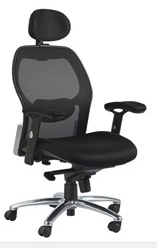Ergonomics of sitting safely. My remarks are intended only to illustrate points in relation to the 2T (3M) concept. Much work has been done in the design of office chairs as a result of the general perception that ’correct Ergonomics of sitting safely’ is required for the avoidance of LBP. In spite of the efforts of chair designers prolonged sitting still results in backache.
The spine is only affected by the bio-mechanics presented to it. An upright work mode can only be a partial solution and can only go some way to meet the spinal 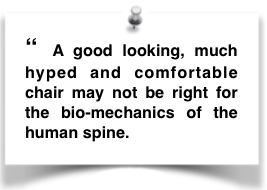 bio-mechanical challenge. A knowledge of the 2T concept, a full solution, is helpful for the understanding of the following comments. Hype and selling points, bells & whistles and apparent comfort are irrelevant. I have yet to see any office chairs on the market that I could recommend for prolonged sitting although the information has been available since 1989.
bio-mechanical challenge. A knowledge of the 2T concept, a full solution, is helpful for the understanding of the following comments. Hype and selling points, bells & whistles and apparent comfort are irrelevant. I have yet to see any office chairs on the market that I could recommend for prolonged sitting although the information has been available since 1989.
A garden recliner. It has only two positions. Both are shown. Simple but very comfortable with an easy, adjustment free transition. It is a 2T system and provides a clue to the development of an office chair and is a forerunner of many of the principles expressed.

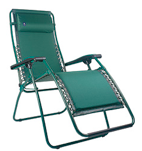 Another garden chair, from France, which now claims to be a recliner and make zero gravity a selling point. I approached them originally with this suggestion and heard no more. The leg-rest retraction is interesting, simple and has points for a 2Tilt construct.
Another garden chair, from France, which now claims to be a recliner and make zero gravity a selling point. I approached them originally with this suggestion and heard no more. The leg-rest retraction is interesting, simple and has points for a 2Tilt construct.
I do not know if their move was post hoc or propter hoc.
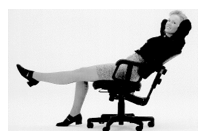
This young lady looks very happy! But perhaps she would be happier with leg and neck support? →
 A common sight. If he had correct neck support he could get on with some work. Admittedly he would need a better computer screen, correctly placed. Nice view!
A common sight. If he had correct neck support he could get on with some work. Admittedly he would need a better computer screen, correctly placed. Nice view!
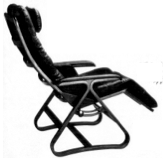 An example of a zero-gravity, reclining chair. It has variable tilt and in the fully recline position the legs are above the level of the head. The headrest is adjustable and pelvic support is possible. The upholstery might give rise to heat build up. See ☛Recliners→.
An example of a zero-gravity, reclining chair. It has variable tilt and in the fully recline position the legs are above the level of the head. The headrest is adjustable and pelvic support is possible. The upholstery might give rise to heat build up. See ☛Recliners→.
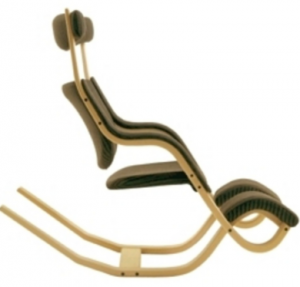
← Good in theory, but I have never actually dared to sit on one.
The Hermann Miller Aeron
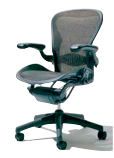 The Aeron chair has been chosen for consideration as an example of a top-range, highly engineered and carefully designed upright office chair. Originally launched in 1994 and developed from an earlier study into furniture for the elderly, with a recliner chair as the inspiration, it incorporated a mesh construction in place of, the then, more common foam-filled upholstery. I was impressed on first seeing this chair and wrote to the effect that it could be seen in most design offices. I liked it’s ability to recline to 45°, as a step towards a 2T Chair, and the mesh construction and remarked that it dissipated heat build-up but also support, of which,at that time, there was none. It shares the same biomechanic problems as any other mid-upright chair. Like them it seems to have reached the limits for remediation with only limited success.
The Aeron chair has been chosen for consideration as an example of a top-range, highly engineered and carefully designed upright office chair. Originally launched in 1994 and developed from an earlier study into furniture for the elderly, with a recliner chair as the inspiration, it incorporated a mesh construction in place of, the then, more common foam-filled upholstery. I was impressed on first seeing this chair and wrote to the effect that it could be seen in most design offices. I liked it’s ability to recline to 45°, as a step towards a 2T Chair, and the mesh construction and remarked that it dissipated heat build-up but also support, of which,at that time, there was none. It shares the same biomechanic problems as any other mid-upright chair. Like them it seems to have reached the limits for remediation with only limited success.
The late John Jukes, who was investigating the incidence level of office musculo-skeletal symptoms, wrote to me “The ergonomic stress symptom pattern is no different to the average office chair”. He also told me that he suggested to them that Gorman’s ‘pelvic support’ should be incorporated in their office chairs 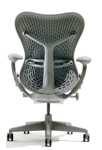 but said this was ignored at that time. Perhaps annoyed by his rebuff, having at last achieved a form of pelvic support, he later wrote “Henry. A large percentage of staff throw out the lumbar support bar because it is too hard and uncomfortable. They do have a pelvic support now. However it has the same problem in that the support is concentrated at the base of the spine and not the iliac crest.” He later wrote “It now incorporates pelvic support and so can be regarded, with reservations, as offering a semi-partial solution to the problem of LBP”.
but said this was ignored at that time. Perhaps annoyed by his rebuff, having at last achieved a form of pelvic support, he later wrote “Henry. A large percentage of staff throw out the lumbar support bar because it is too hard and uncomfortable. They do have a pelvic support now. However it has the same problem in that the support is concentrated at the base of the spine and not the iliac crest.” He later wrote “It now incorporates pelvic support and so can be regarded, with reservations, as offering a semi-partial solution to the problem of LBP”. 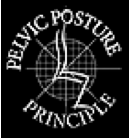 The Gorman design, suggested to them by John Jukes in the first place might have saved them and their clients, 2 decades of trouble. Gorman’s “Pelvic Posture Principle” is not generally understood and pressure is still directed above the pelvic brim and to the midline and not to the iliac crests. ☛Pelvic support→
The Gorman design, suggested to them by John Jukes in the first place might have saved them and their clients, 2 decades of trouble. Gorman’s “Pelvic Posture Principle” is not generally understood and pressure is still directed above the pelvic brim and to the midline and not to the iliac crests. ☛Pelvic support→
Evident in the photograph, above, the seat is convex, an example of the ‘Off Load’ system’ which the Makshous study showed to have biomechanic advantages. The convex front half goes a little way to being a FTS accounting for some users admitting that they usually perched on the front edge. This seat shape allows this chair to be upgraded from a simple upright chair.
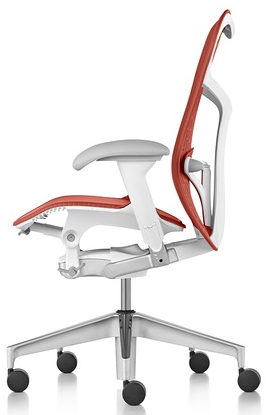 The pelvic support, included with the ‘Off Load’ system, is the only component of the Hermann Miller, and other, ranges that can lift these otherwise well designed chairs from at least one of the seriously adverse effects of the common upright chair (‘machines for making backache’). The back support only becomes ‘iliac’ at it’s lowest adjustment, A more user friendly plastic band whose depth can be adjusted replaces the uncomfortable adjustable (usually wrongly) rod. The back view shows that it is still slightly too high and likely to act as an adverse lumbar support.
The pelvic support, included with the ‘Off Load’ system, is the only component of the Hermann Miller, and other, ranges that can lift these otherwise well designed chairs from at least one of the seriously adverse effects of the common upright chair (‘machines for making backache’). The back support only becomes ‘iliac’ at it’s lowest adjustment, A more user friendly plastic band whose depth can be adjusted replaces the uncomfortable adjustable (usually wrongly) rod. The back view shows that it is still slightly too high and likely to act as an adverse lumbar support.
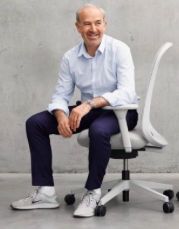 The new Lino chair by Herman Millar mentions sacral support, which ‘nudges you into better posture’. “…the cleverest way is a design feature that subtly corrects your posture so that the chair doesn’t need to be adjusted so much—and thus doesn’t need all the moving parts that make other task chairs expensive.” (This sounds as if they have read this work.) A step in the right direction, at last, some 20 years after the recommendation of Jukes. The photograph is of one of the co-designers, Sam Hecht of Industrial Facility, photographed by Gerhardt Kellerman.
The new Lino chair by Herman Millar mentions sacral support, which ‘nudges you into better posture’. “…the cleverest way is a design feature that subtly corrects your posture so that the chair doesn’t need to be adjusted so much—and thus doesn’t need all the moving parts that make other task chairs expensive.” (This sounds as if they have read this work.) A step in the right direction, at last, some 20 years after the recommendation of Jukes. The photograph is of one of the co-designers, Sam Hecht of Industrial Facility, photographed by Gerhardt Kellerman.
The OKAMURA ATLAS chair & Cruise concept.
 “Looks familiar, Henry?” was the message from John Jukes about this office chair. Sure enough it showed the semi-reclined work position that I had been advocating since 1998. Ten years after my original suggestion, Okamura has recognised the importance of a reclined mode in their Cruise concept. However, the 2T concept has additional requirements for it’s implementation to be effective for an office or work chair and not to be simply a recliner or a ’zero gravity chair’.
“Looks familiar, Henry?” was the message from John Jukes about this office chair. Sure enough it showed the semi-reclined work position that I had been advocating since 1998. Ten years after my original suggestion, Okamura has recognised the importance of a reclined mode in their Cruise concept. However, the 2T concept has additional requirements for it’s implementation to be effective for an office or work chair and not to be simply a recliner or a ’zero gravity chair’.
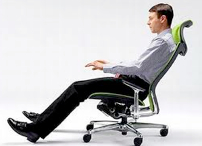
 The designers had probably not seen the principles that I had formulated and tested at Cambridge, to make this mode optimally functional. In my opinion, the reclined mode made this chair the best on the market at that tme. It has plenty of room for improvement. For further consideration see ☛ Okamura Atlas→
The designers had probably not seen the principles that I had formulated and tested at Cambridge, to make this mode optimally functional. In my opinion, the reclined mode made this chair the best on the market at that tme. It has plenty of room for improvement. For further consideration see ☛ Okamura Atlas→
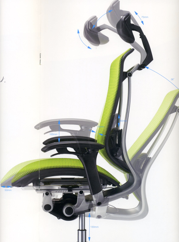 The OKAMURA CONTESSA chair
The OKAMURA CONTESSA chair
It includes some of my 2T points. Okamura had, by now, seen my ‘Sitting Safely’ (protected by an nda) and it is possible that the designer, Giugiaro, had also seen it too.
The OKAMURA LEOPARD chair
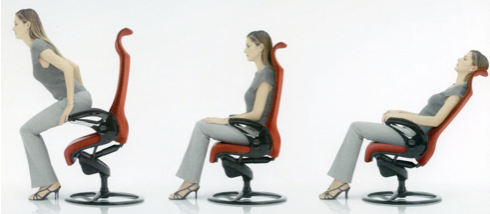 Not intended as a work-chair, it is aesthetically superb and looks right, however the fixed head-rest is only excellent for contemplating the ceiling. A forward tilt is possible but there is no contouring to prevent slipping and it seems to be used for rising from the chair. The intermediate range is stiff which makes it difficult to fully recline. The seat is fixed at a low level. This allows the feet to rest on the floor in the reclined mode, as shown. I am told that this causes problems for tall people who have tried it and an adjustable table may be required (no bad thing). Essentially a waiting room chair, jt would ne unsuitable for office work.
Not intended as a work-chair, it is aesthetically superb and looks right, however the fixed head-rest is only excellent for contemplating the ceiling. A forward tilt is possible but there is no contouring to prevent slipping and it seems to be used for rising from the chair. The intermediate range is stiff which makes it difficult to fully recline. The seat is fixed at a low level. This allows the feet to rest on the floor in the reclined mode, as shown. I am told that this causes problems for tall people who have tried it and an adjustable table may be required (no bad thing). Essentially a waiting room chair, jt would ne unsuitable for office work.
Pledge BT3 20/20 (Task)
Gorman, an engineer turned chiropractor, worked with PLEDGE to produce office chairs incorporating pelvic support. Controlled trials by John Jukes of VESTRA showed them to be significantly more effective in reducing back shoulder and neck pain, compared with similar chairs. and advocated the Pledge BT3 20/20 (Task) pelvic support chair to reduce LBP problems in the optimised office environment. These office chairs, incorporating Gorman’s ‘pelvic (actually ‘iliac’) support have been in use over the last 10 years and some 40,000 are in use. It has been estimated that considerable savings 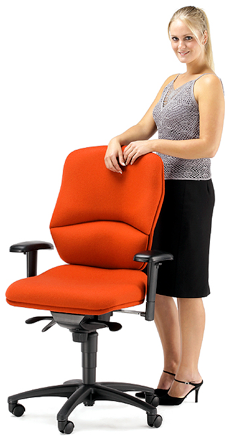
 have resulted due to reduced absenteeism and increased staff performance due to the improved ergonomics (Jukes J). Initial outlay of cost is also considerably less than the two chairs considered previously.☛ Pelvic Posture→
have resulted due to reduced absenteeism and increased staff performance due to the improved ergonomics (Jukes J). Initial outlay of cost is also considerably less than the two chairs considered previously.☛ Pelvic Posture→
The Howarth Zody
This is another good upright office chair that incorporates ‘Pelvic Support’, here called PAL™. This allows it to be considered as a semi-partial solution for full Safe Sitting.
 As with any upright chair it has the inherent disadvantage of the increased axial loading.
As with any upright chair it has the inherent disadvantage of the increased axial loading.- It has the advantage of a forward tilt mode and a possibly adequate pelvic support in the upright mode.
- It boasts high engineering, ergonomic research based on maximising comfort and many adjustments, bells and whistles. ‘200 test persons have adjusted the support in the lower back region again and again until they felt comfortable. The sensors provided the scientists with data which they evaluated using pressure mapping technology. The procedure was repeated several times and the results were clearly confirmed.’ All probably excellent but totally irrelevant for full biomechanical requirements. See ☛ Comfort?→
- To some extent this has been addressed by incorporating a pelvic support system. This fails as it is adjustable and does not have the comfortable V-shaped iliac support of the original Gorman ‘Pelvic Posture’ concept.
- Questionably it also incorporates lumbar support. If adjusted to produce effective lumbar lordosis this would counteract the important pelvic support. Adjustment to reduce this effect is counter intuitive. In my experience adjustments are usually made in the wrong direction. People have preconceived ideas as to what ‘should’ be correct and can be misleading in efforts to determine what best addresses the bio-mechanical imperatives.
- Adjustment of the seat surface up to 7 cm to the front and back is irrelevant. Only the ischial tuberosity must be supported. Limitation of the backrest’s opening angle to six steps is also irrelevant. Ideally this should adapt to the full reclined mode and intermediate steps avoided.
- When shifting the weight to the front, the seat surface follows with a slight inclination downwards. This is good. If this was the only mode, then many of the other supports and adjustments would become irrelevant….
- Memory foam seat. Excellent. A strong + point when tilted forward.
- Only really suitable for short term sitting.
The Albion range

 There is a wide range of reasonably ergonomic office chairs. Their Spynamic range claim extra ergonomic advantages. The chair shown on the left has a somewhat over long seat-pad but is is bettered in the example on the right. It looks as if there may be messy unneccesary adjustment controls. http://albionchairs.com/office-chairs-by-application.htm
There is a wide range of reasonably ergonomic office chairs. Their Spynamic range claim extra ergonomic advantages. The chair shown on the left has a somewhat over long seat-pad but is is bettered in the example on the right. It looks as if there may be messy unneccesary adjustment controls. http://albionchairs.com/office-chairs-by-application.htm
 Ferrari gets into seating
Ferrari gets into seating
Peter Bessey sent me this ref. with the comment “Guess they missed an opportunity to work with your specs, Henry. Would have been interesting to see them come up with a properly engineered solution, alongside the carbon fibre composites. All the best, Peter”
Yes. Only really suitable for short term sitting. HAS
The Modern Zure Office Chair
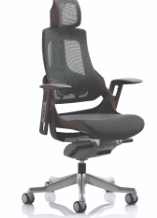 “Boldly going where no chair has gone before. The Zure takes you to a new comfort destination. Our unique range of this distinctive, uber stylish posture perfect seating solution has it all. There is fine mesh, fully upholstered, partly upholstered and stunning flexible elastomer options. The seat and backrest are carefully contoured to provide maximum comfort. The high-quality outer skeleton wraps the user in touch point technology. Padded armrests on the fabric and leather options provide pleasing eye-appeal whilst the elastomer versions have colour coded armrests.” “Orthopaedic designed frame”. Having bought the hype and the chair for $736, the user would be well advised to study BACKACHE? For users and patients (only) if prolonged use is intended. Only really suitable for short term sitting.
“Boldly going where no chair has gone before. The Zure takes you to a new comfort destination. Our unique range of this distinctive, uber stylish posture perfect seating solution has it all. There is fine mesh, fully upholstered, partly upholstered and stunning flexible elastomer options. The seat and backrest are carefully contoured to provide maximum comfort. The high-quality outer skeleton wraps the user in touch point technology. Padded armrests on the fabric and leather options provide pleasing eye-appeal whilst the elastomer versions have colour coded armrests.” “Orthopaedic designed frame”. Having bought the hype and the chair for $736, the user would be well advised to study BACKACHE? For users and patients (only) if prolonged use is intended. Only really suitable for short term sitting.
A selection from ‘Posturite’.
A good selection but only really suitable for short term sitting.
Dynamic seating & motion
The basic model in this category is the ‘Wobbly Ball’. A good idea but who wants to sit on this in an office? So let’s call it a ‘Balance’ chair.
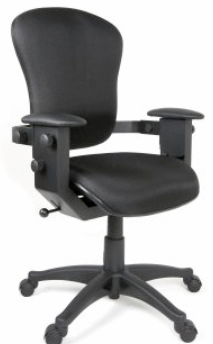 The SwingSeat from SmartMotion Technology
The SwingSeat from SmartMotion Technology
Basically an upright chair. With the seat forward tilted, lumbar lordosis is ensured. It’s self adjusting controls allow a range from about 40° of reclination from the upright to a 10° of forward tilt which is performed effortlessly, avoiding the usual confusing plethora of adjustment controls. Manual controls are present for backrest height, angle, depth, resistance and seat height and armrest control. The concept behind this design is to enable constant small amplitude spinal movement which helps ensure the pressure gradients required for adequate nutrition of the disc. The ergonomic evidence for the importance of enabling movement which is comforting and ensures health of the disc constituents is summarised by Rani Leuder in Ergonomics Review of The Swing Seat See Lueder R. Anatomical, physiological and health Considerations relevant to the SwingSeat. 2002; Ergonomics Review. She is President of Humanics ErgoSystems, ☛ www.humanics-es.com→
The PESKA chair
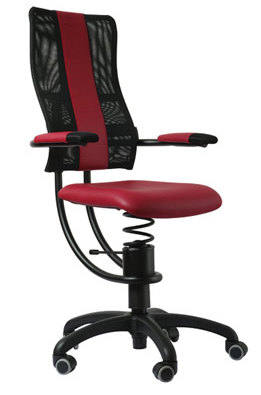 This ‘dynamic’ chair has the option to fix the balance mechanism. It recommends sitting on a balance chair only for a limited time, say 3 times a day for 30 minutes. Sitting on office chairs with active balance mechanism throughout the day would be the same as if you exercised continuously for 8 hours. The same effect occurs with the unstable intermediate mode in the 2T concept, but with stable positions at the end of ranges there is no need for adjustment.
This ‘dynamic’ chair has the option to fix the balance mechanism. It recommends sitting on a balance chair only for a limited time, say 3 times a day for 30 minutes. Sitting on office chairs with active balance mechanism throughout the day would be the same as if you exercised continuously for 8 hours. The same effect occurs with the unstable intermediate mode in the 2T concept, but with stable positions at the end of ranges there is no need for adjustment.
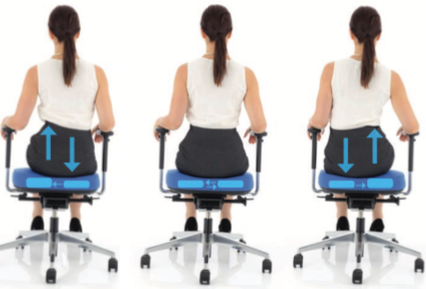 The KOEHL AIR-SEAT, from Holland.
The KOEHL AIR-SEAT, from Holland.
“Stimulates multidimensional micro-movements and trains by frequent changes the low-lying back muscles. Balancing on the KOEHL AIR-SEAT by gentle lateral pelvic movements, by a pair of air cushions. Emphasises the rehabilitation function. Comforting and aids IV disc nutrition which helps avoid early disc degeneration. http://www.koehl.com/fileadmin/user_upload/Dokumente/AIR_SEAT/koehl_Brosch_AIR-SEAT_29092014_EN.pdf
WAGNER chair
The Dondola hinge system allows a controlled all-round instability and a trial when incorporated in a Wagner chair showed reduction of morbidity when compared to office chairs without the system. A full account is given in ☛ EXERCISE & movement→
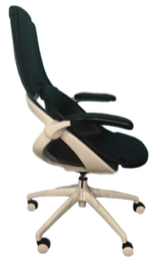 BackStrong Chair
BackStrong Chair
An awful example of OTT hype tells us that “this chair is’ the best in the world’ and ‘This means disrupting the seating industry -‘. It was helped designed by ‘Dennis Colonello (D.C.), the top Chiropractor on Earth:. See this at → BackStrong Chair
It appears to be an upright chair, needing a desk for work, This is likely to prove retrograd, even Dickensian (See Bessey in OFFICE WORK-STATIONS), in a few years when deskless chairs, as part of a sit/stand workstations, come on line. As an upright chair it remains only a partial solution to the bio-mechanic ill effects of proloned sitting. It’s remedial points are :-
- dynamic seating. Called here ‘ Sit-In-Motion’.
- A forward tilted seat (The FORWARD TILTED SEAT (FTS). )
- This is helped by an independant moving seat pan.This reminds me of my 2013 Cambridge student model (See OFFICE WORK-STATIONS ) which is actually a full work station incorporating the 2T concept.
-
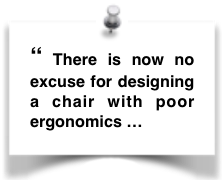 This seat has the components to progress it to bio-mechanic (ergonomic) fully remediated office chairs for prolonged work.
This seat has the components to progress it to bio-mechanic (ergonomic) fully remediated office chairs for prolonged work.- I would urge the manufacturers to take advantage of this option which would result in a truly disruptive system that would sweep the chair industry. Who wants to use a work-chair that is not ergonomically optimised?
- Worrying is that the back support appears to extend above the pelvic brim. In the verbal blurb it is described as ‘lower thoracic’ which would be bio-mechanically adverse (See BACKRESTS. Pelvic support v. Lumbar.).. Perhaps it would be as well if ‘the top Chiropractor on Earth’ had a word with John Gorman who is also a chiropractor with the advantage of a prior top engineering degree from Cambridge University. Chiropractors are deeply suspicious, perhaps with reason, of us physicians. I was trained by James Cyriax the ‘Father of Orthopaedic Medicine’ who wrote a book fiercely attacking Osteopaths and Chiropractors. However Gorman overcame his suspicians as I discovered that he knew his spinal anatomy and bio-mechanics and we were speaking the same language.
- Yet another “radically new” development which isn’t new except to those who came into the business recently (ie less than 30 years ago)”. Unattributed, but guess who?
- In the present form it should probably not be used for longer than 6 hours.
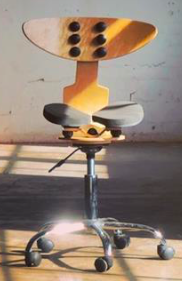 ‘ChairSix’ by Si Freeman
‘ChairSix’ by Si Freeman
The design is sophisticated and simple – good. The backrest is adjustable and can be adjusted to the adverse ‘lumbar’ position. – Bad. Height location is critical. ☛ BACKRESTS. Pelvic support v. Lumbar. The width of the back rest could be a problem for work-related activities. If at a desk or table, its width impedes the elbow for keyboard and mouse activities. This issue was well-proven many years ago, by the design of chairs stretching back to Fred Scott’s Hille Supporto chair, where the narrowed spinal backrest was a deliberate feature and seems particularly popular in Scandinavian furniture designs still. The seat(s) seem to be forward tilting – good. The somewhat flexible, rubber foam pads which sit proud of the pan, on raised platforms, act as small pivots that adjust the pads to the body form and seemed to work well and gave a sense of flexibility and comfort to the seat pan. – good. The 6 knobbles on the back-rest,may represent some type of ‘massage’ feature, as seen on some Asian add-in seat pads for vehicles and office seating and that the slight wobble from the pivoting pads, also provides the movement needed to move the back against them. They are not in the mid-line – good.
It seems to me that ‘Pelvic Support’ and a FTS are not complementary but ‘either or’. The ISCHIAL OFF LOAD system gets round this with a convex seat-pan providing a FTS in front and slope towards pelvic support at the back. In spite of these improvemrnts this remains an upright chair with their considerable ergonomic disadvantage. Only OK for shortish sits as in a sit/stand office. ☛ Sit Stand & stools
Cobhamly High Back Mesh Office Chair
I have not seen this chair. It seems to have ‘pelvic support’, although possibly above the 20cm allowed height. The price seems OK. Their Boston High Back Executive leather effect operator chair. Features a heavy duty gas seat height adjustment and fully synchronised tilt to seat and back rest with adjustable tension control. I do not know how this works out, But could probably be adjusted to comply with the 2T concept with optimised comfort. It has features that suggest that the designer may have seen this blog.
AN EXISTENTIAL THREAT – A new breed of office chairs with a reclined work mode.
WORKCHAIRS, a new breed with a reclined mode.→
As predicted this is begining to emerge. A number of ‘workstation’ type office chairs are appearing which include a reclined work mode and so are superior to the present (2016) upright conventional upright models. Appearing to ignore the science and based on engineering they do not invite a great uptake inspite of extensive PR.
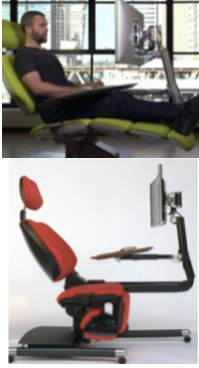 Now, in 2015, an office chairs is proposed, the Altwork that has at least an upright and reclined work position as I had been advocating since 1998. However, it fails the functionality of the 2t optimisation. These faults could easily be corrected and so with reservations, it is potentially the best work-chair in the market. See a more detailed account in WORKCHAIRS, a new breed with a reclined mode.→ . . also (http://altwork.com).
Now, in 2015, an office chairs is proposed, the Altwork that has at least an upright and reclined work position as I had been advocating since 1998. However, it fails the functionality of the 2t optimisation. These faults could easily be corrected and so with reservations, it is potentially the best work-chair in the market. See a more detailed account in WORKCHAIRS, a new breed with a reclined mode.→ . . also (http://altwork.com).
The Cambridge trials showed the elegance, simplicity, cost effectiveness and greatly enhanced ergonomics of the 2T concept. This provides an opportunity for the existing manufacturers and any entering the field. Top manufacturers are already recognising that they have come to the end of the line for ergonomics. Backache (LBP) and other spinal & muscle-skeletal conditions still persist resulting in stress and lowered productivity.


